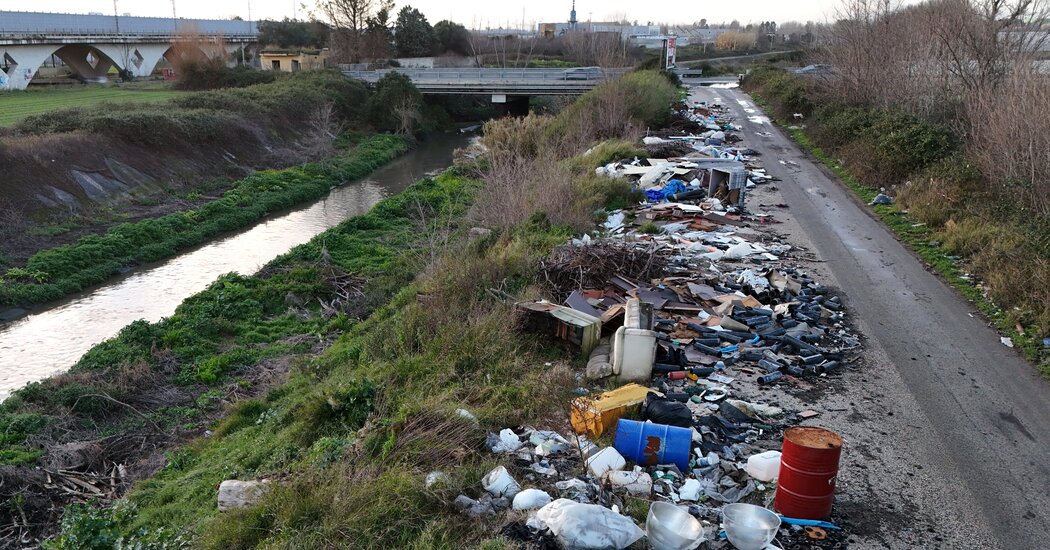Until a few days ago, Antonietta Moccia, a 61-year-old housewife, had little hope that the Italian authorities would ever tackle the illegal waste disposal that had long plagued her town and others just north of Naples.
Her daughter was diagnosed with a rare cancer at age 5 in an area where clusters of cancers have been linked to pollution. But her years of marches, sit-ins and comforting neighbors whose lives were upended by the untimely deaths of loved ones had yielded little.
Case in point, she nodded to a mound of garbage — construction debris, sundry objects and plastic bags stuffed with varied refuse — piled along a dusty back street in Acerra, her hometown.
“We need less talk, more action,” she said. “There’s been talk for years.”
Recently, the European Court of Human Rights let it be known that it felt much the same. The court based in Strasbourg, France, found that the Italian authorities had long been aware of the illegal dumping in an area colloquially known as “the land of fires” because of the persistent burning of toxic waste.
But it said that local and national authorities had repeatedly failed to act. The court cited a 1997 report to Parliament that said the dumping had been going on since at least 1988.
“Progress had been glacial,” seven judges ruled unanimously, saying that residents had been denied their “right to life.” It ordered the government to take immediate action and report back in two years.
Residents and environmental activists said they hoped the decision would finally break the logjam of inaction to clean up one of the poorest areas of Italy, where some three million people are scattered among 90 municipalities.
An ongoing study by Italy’s top heath authorities found in a 2023 report that the mortality rate for people in this part of Campania was 9 percent higher than the rest of the region. People had a greater chance of dying from malignant tumors (10 percent higher) or circulatory system diseases (7 percent higher), and in some cases the statistics were stark: Instances of liver tumors in women were 31 percent higher.
“We hope there will be a jolt of consciences in all Italian politicians,” said Enrico Fontana, who monitors environment and legality for Legambiente, Italy’s largest environmental group. “The hope is that this landmark ruling will trigger a real national unity with a national strategy that sees forces on every level react together to solve the problem.”
The case involved complaints by scores of residents seeking to know whether Italy had violated Article 2 of the Convention of Human Rights, the right to life, by failing to clean up the mess, and whether the Italian authorities had also violated people’s right to information about the pollution in the area.
An additional 4,700 citizens have filed complaints in Strasbourg concerning the same issues, and those cases could move forward should Italy fail to prepare an overall strategy within the two-year deadline set by the court.
The Strasbourg case drew on the findings of several parliamentary commissions, scientific studies, reports by environmental groups and the opinions of experts, showing that the area had willfully been allowed to become a dumping ground.
Manufacturers in Italy, and beyond, experts said, cut secret deals with the Camorra, as the local mafia is known, to illegally dispose of hazardous waste for a fraction of the cost of legal disposal.
By burying the waste in its backyard, the Camorra could ensure a measure of protection, and silence.
“It’s what is known as a sacrifice area, a vulnerable, low-income, low-education community that was already struggling” socially and economically, said Marco Armiero, an expert in political ecology who weighed in on the case for the court.
The opening of an incinerator in Acerra in 2009 “added insult to injury to an already contaminated community” and brought no relief to toxic waste management, he said in telephone interview. As a result, he added, “these communities don’t trust the institutions much anymore.”
Rebuilding trust can come only from doing the court’s bidding, he said.
The European court gave Rome two years to draft a “comprehensive strategy” to address the situation, including the decontamination of areas where toxic waste had been buried and burned.
It calls for Italy to set up “an independent monitoring mechanism and a public information platform” for residents. The court found that “it was impossible to get an overall sense of where had yet to be decontaminated,” and called for better coordination among institutions to tackle this issue.
“The overall situation remains worrying,” said Fabrizio Bianchi, a researcher at the National Research Council Institute of Clinical Physiology in Pisa. Despite decades of delays, he said, time is still of the essence.
“The further we go on, if decontamination is not undertaken and the pressure on the territory is not mitigated, the more the negative effects will be felt,” he said.
Antonella Mascia, a lawyer who represented some of the people who filed a complaint, said it had been rare for the court to be so detailed with its recommendations to Italy, specifying a two-year time limit.
After that period, the court said it would also address the question of financial compensation for those who put in claims. “But it was not about money, but about the verification that there was a violation in order to bring about change — this is the spirit” of the claim, Ms. Mascia said.
Her colleague in Acerra, Valentina Centonze, said Italy had to make it a priority to find funds to fulfill the court’s recommendations, from decontaminating the territory to monitoring it so that new dumps are not developed. As it is, garbage is strewed along back roads throughout the area.
“To resolve a problem, you have to invest in it,” she said.
The court was also clear that the local population should no longer be kept in the dark about what was happening in its territory, for better or worse.
“There has to be transparency about what was not done and what has to be done,” said Alessandro Cannavacciuolo, a local environmental activist.
He said he had been shocked into awareness about the pollution when lambs with two heads or two tails or one eye started to be born on the family farm.
The health authorities eventually ordered the entire flock to be put down. His uncle, Vincenzo, died within a few weeks of a lung cancer that had metastasized.
Earlier this month, he was invited to a meeting at the Prefecture of Naples with assorted health authorities, lawmakers, law enforcers and environmental activists to address the court’s ruling. He said tangible proposals had been in short supply.
“There is talk, talk, talk. Eh, this territory has already heard a lot of talk,” he said.
Attempts to reach the Campania regional authorities were unsuccessful.
Mr. Cannavacciuolo, who is 36, could leave his home region but has chosen to stay and fight. “Our roots are here,” he said. “Why abandon a land that belongs to us? The people who have polluted it are the ones who should go away.”
Others can’t wait to leave. Maria D’Alise, 18, known to everyone as Miriam, was just 5 when she was diagnosed with a kind of brain tumor that affects about 650 children per year in the European Union. “In Acerra, a town of 60,000, there were three cases,” said Ms. Moccia, her mother.
Now cancer free but still dealing with the aftereffects of her treatment, Ms. D’Alise is in her last year of high school and hopes to become a tattoo artist after graduating. Not in Acerra.
“This is where I had what I had,” she said, “and should I have children when I grow up, I don’t want them to have my same experience, so I am leaving.”





